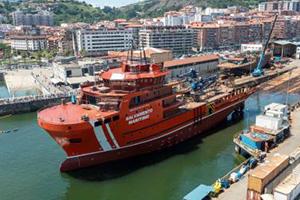Heroinas de Salvora Project

SPAIN
1.Greening Operations
Salvamento Marítimo, the organisation in charge of maritime traffic control, search and rescue operations, maritime safety, and protection of the maritime environment within Spain, made sustainability a priority when renewing a key vessel in its fleet.
The challenge was to create a new, multi-purpose vessel that not only had similar capabilities to the existing flagship vessels, but which also had the smallest environmental footprint possible. The final design went even further than compliance with existing environmental regulations, integrating a hybrid engine, a ballast water treatment plant (normally only integrated in vessels for international journeys), and catalysers in the engine exhausts to reduce NOx emissions.
The vessel is also equipped with the capability to store and operate drones. As well as giving extra surveillance capabilities that otherwise could only have come from helicopter support, an on-board drone will allow operations to continue in open sea without having to return to land, thus saving fuel.
Named after three young Spanish women who rescued dozens of people from a shipwreck at the beginning of the last century, the Heroínas de Sálvora promises a net reduction of 3 000 tonnes of CO2 when compared with the existing fleet. The vessel will enter into full service later in 2024.

Salvamento Marítimo, the organisation in charge of maritime traffic control, search and rescue operations, maritime safety, and protection of the maritime environment within Spain, made sustainability a priority when renewing a key vessel in its fleet.
The challenge was to create a new, multi-purpose vessel that not only had similar capabilities to the existing flagship vessels, but which also had the smallest environmental footprint possible. The final design went even further than compliance with existing environmental regulations, integrating a hybrid engine, a ballast water treatment plant (normally only integrated in vessels for international journeys), and catalysers in the engine exhausts to reduce NOx emissions.
The vessel is also equipped with the capability to store and operate drones. As well as giving extra surveillance capabilities that otherwise could only have come from helicopter support, an on-board drone will allow operations to continue in open sea without having to return to land, thus saving fuel.
Named after three young Spanish women who rescued dozens of people from a shipwreck at the beginning of the last century, the Heroínas de Sálvora promises a net reduction of 3 000 tonnes of CO2 when compared with the existing fleet. The vessel will enter into full service later in 2024.


